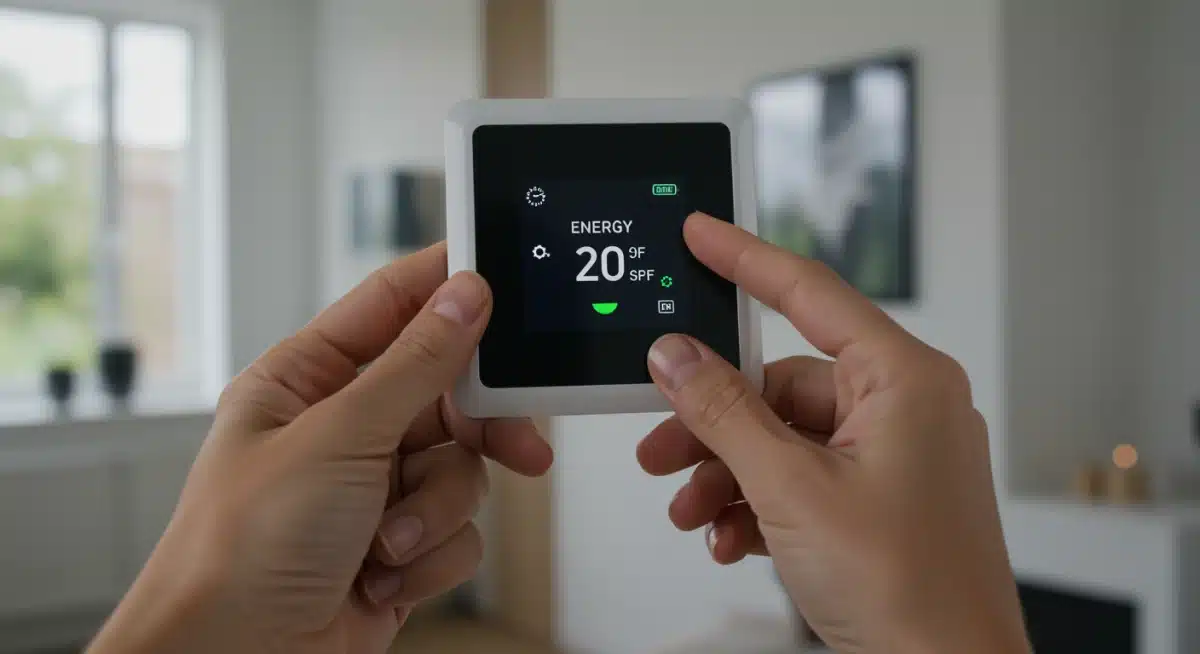Cut Household Bills 20% in 2025: Actionable Savings

Achieving a 20% reduction in your household’s monthly bills by 2025 is an attainable goal through strategic planning and implementing practical solutions that offer significant financial impact for families in the United States.
As families in the United States look to strengthen their financial footing, the focus on how to reduce household bills by 20% in 2025 has become a critical topic. This comprehensive guide outlines actionable steps and practical solutions designed to deliver substantial cost savings, ensuring a more stable economic future for your home.
Understanding Your Current Financial Landscape
Before any significant savings can be realized, it is imperative to gain a clear understanding of where your money is currently going. Many households operate without a detailed budget, making it challenging to identify areas ripe for reduction. The first step involves meticulously tracking all income and expenses over a period, typically one to three months.
This initial audit allows families to pinpoint recurring costs, identify unnecessary expenditures, and recognize patterns in spending. Without this foundational knowledge, attempts to reduce household bills are often haphazard and less effective. Financial experts emphasize that this diagnostic phase is not about judgment but about data collection, providing an objective view of your financial habits.
The power of a detailed budget
- Categorize all expenses: Group spending into fixed (rent/mortgage, loans) and variable (groceries, entertainment, utilities) categories.
- Track every dollar: Utilize budgeting apps, spreadsheets, or even pen and paper to log every transaction.
- Identify spending leaks: Small, frequent purchases often accumulate, revealing hidden opportunities for savings.
By diligently documenting where every dollar goes, you empower yourself with the information needed to make informed decisions. This clarity is the cornerstone of any successful strategy to reduce household bills and achieve your 20% savings target for 2025.
Optimizing Utility Costs: A Major Opportunity
Utility bills often represent a significant portion of a household’s monthly expenditure, presenting a prime area for substantial savings. Electricity, gas, water, and internet services all offer opportunities for reduction through conscious consumption and strategic adjustments. The goal is not just to cut back, but to optimize usage for maximum efficiency.
Many households overlook the cumulative impact of small changes, such as unplugging electronics, adjusting thermostat settings, or fixing leaky faucets. These seemingly minor actions can collectively contribute to a noticeable decrease in monthly utility costs. Furthermore, exploring alternative service providers or renegotiating existing contracts can yield significant financial benefits.
Energy efficiency upgrades and habits
- Smart thermostat installation: Program your thermostat to adjust temperatures automatically when you are away or asleep.
- LED lighting conversion: Replace incandescent bulbs with energy-efficient LEDs, which consume significantly less power and last longer.
- Appliance efficiency: Ensure appliances are well-maintained, and consider upgrading to ENERGY STAR certified models when possible.
Beyond physical upgrades, cultivating energy-saving habits is crucial. Turning off lights, taking shorter showers, and air-drying clothes are simple yet effective ways to reduce consumption. Proactively managing your utility usage is a direct path to significantly reduce household bills and meet your 2025 savings goal.

Strategic Approaches to Food Expenses
Food is a necessity, but it can also be one of the most flexible categories in a household budget, offering considerable potential to reduce household bills. Many families find themselves spending more than necessary on groceries, dining out, and impulse food purchases. A strategic approach to meal planning, shopping, and consumption can unlock substantial savings.
The key lies in mindful purchasing and minimizing waste. Planning meals in advance, creating detailed shopping lists, and sticking to them can prevent impulse buys and ensure that ingredients are used efficiently. Furthermore, exploring cost-effective food sources, such as farmers’ markets or bulk stores, can provide quality products at lower prices.
Smart grocery shopping tips
- Meal planning: Plan all meals for the week to avoid last-minute takeouts and reduce food waste.
- Shop with a list: Stick strictly to your grocery list to prevent impulse purchases.
- Compare prices and use coupons: Look for sales, use digital coupons, and compare unit prices across brands.
- Cook at home: Preparing meals at home is almost always cheaper than dining out or ordering delivery.
By adopting these practices, families can significantly curb their food spending. This disciplined approach not only helps to reduce household bills but also encourages healthier eating habits and better financial control over a vital expense category.
Re-evaluating Subscriptions and Memberships
In the digital age, subscription services and various memberships have become ubiquitous, often accumulating unnoticed until they represent a significant drain on monthly finances. From streaming platforms and gym memberships to software subscriptions and monthly boxes, these recurring charges can quickly add up, making them a prime target when looking to reduce household bills.
Many households subscribe to services they rarely use or have multiple subscriptions that offer similar content. A thorough audit of all recurring charges is essential to identify redundancies and eliminate unnecessary expenses. This process should be conducted regularly, as new services emerge and usage patterns change over time.
Auditing your recurring expenses
- List all subscriptions: Compile a complete list of every recurring charge, including the cost and frequency.
- Assess usage: Determine if you genuinely use and derive value from each service.
- Cancel or downgrade: Eliminate unused subscriptions or downgrade to cheaper tiers if available.
- Negotiate terms: For essential services like gym memberships, inquire about lower rates or special offers.
By systematically reviewing and optimizing your subscriptions and memberships, you can free up a considerable amount of money each month. This direct action provides immediate relief to your budget and is a straightforward way to reduce household bills efficiently.
Lowering Transportation and Insurance Costs
Transportation and insurance are two areas where significant savings can often be found, yet they are frequently overlooked when families seek to reduce household bills. For many, car payments, fuel, maintenance, and insurance premiums constitute a substantial part of their monthly budget. Similarly, various insurance policies—auto, home, life—can be optimized for better value.
Reducing transportation costs might involve rethinking commuting habits, consolidating trips, or even considering alternative modes of transport. For insurance, it’s not about cutting coverage indiscriminately but about ensuring you have the right policies at the most competitive rates. Loyalty to a single provider does not always guarantee the best deal.
Strategies for transportation and insurance savings
- Optimize driving habits: Drive less, carpool, use public transport, or combine errands to save on fuel.
- Maintain your vehicle: Regular maintenance prevents costly breakdowns and improves fuel efficiency.
- Shop for better insurance rates: Compare quotes from multiple providers annually for auto, home, and other insurance types.
- Bundle policies: Many insurance companies offer discounts when you bundle multiple policies, such as home and auto.
- Increase deductibles: If financially feasible, increasing your deductible can lower your monthly premiums, but ensure you can cover the higher out-of-pocket cost if an incident occurs.
Proactive management of these essential expenses can lead to substantial long-term savings. Taking the time to research and adjust your transportation and insurance arrangements is a highly effective method to reduce household bills and contribute to your 20% target.
Debt Management and Financial Planning
High-interest debt, such as credit card balances or personal loans, can severely inflate monthly expenses and hinder efforts to reduce household bills. Effective debt management is not just about making minimum payments; it’s about strategically reducing the principal and interest burden to free up cash flow. This often involves a combination of debt consolidation, refinancing, and disciplined repayment strategies.
Beyond debt, proactive financial planning, including setting clear savings goals and building an emergency fund, can prevent future financial strain. A well-structured financial plan provides a roadmap for managing income and expenses, ensuring that unexpected costs don’t derail your efforts to achieve sustainable savings.
Key debt reduction tactics
- Debt snowball or avalanche method: Choose a strategy to aggressively pay down debt, either by focusing on the smallest balance first (snowball) or the highest interest rate first (avalanche).
- Consolidate high-interest debt: Explore options like a personal loan or balance transfer credit card with a lower interest rate to simplify payments and reduce overall interest paid.
- Negotiate with creditors: In some cases, creditors may be willing to lower interest rates or offer modified payment plans, especially if you demonstrate financial hardship.
By tackling debt head-on and integrating sound financial planning into your routine, you not only reduce household bills in the short term but also build a stronger, more resilient financial future for your family. This holistic approach is vital for achieving and sustaining significant cost savings by 2025.
Key Strategy |
Brief Description |
|---|---|
Budget Analysis |
Track all expenses to identify spending patterns and areas for reduction. |
Utility Optimization |
Implement energy-saving habits and smart home devices to lower utility costs. |
Subscription Audit |
Review and cancel unused or redundant subscription services. |
Debt Reduction |
Strategically pay down high-interest debt to free up monthly cash flow. |
Frequently Asked Questions About Bill Reduction
Yes, a 20% reduction is highly achievable with consistent effort and strategic planning. Many households find significant savings by combining small adjustments across multiple categories like utilities, food, and subscriptions, leading to a substantial cumulative impact.
The initial and most crucial step is to create a detailed budget. Track all your income and expenses for at least one month to identify exactly where your money is going. This clarity provides the foundation for targeted savings efforts.
It is recommended to review your budget and spending habits monthly to stay on track. A more comprehensive review, including comparing service providers and renegotiating contracts, should be done annually to ensure you are always getting the best value.
Absolutely. Smart home devices like thermostats, lighting systems, and smart plugs can automate energy savings. They allow for precise control over energy consumption, often learning your habits to optimize usage and significantly lower utility expenses over time.
High-interest debt can be a major barrier to reducing overall bills. Prioritizing debt repayment, especially high-interest credit cards, can free up substantial monthly cash flow. Consider strategies like debt consolidation or the snowball/avalanche methods to accelerate your progress.
Looking Ahead: Sustaining Your Savings into the Future
The journey to significantly reduce household bills by 20% in 2025 is not a one-time event but an ongoing commitment to financial mindfulness. The strategies discussed here provide a robust framework for achieving your immediate savings goals. However, sustaining these gains and potentially finding further efficiencies requires continuous vigilance and adaptability. As economic conditions shift and new technologies emerge, staying informed about financial best practices and revisiting your household budget periodically will be crucial. This proactive stance ensures your family’s financial health remains robust, prepared for future challenges and opportunities.





